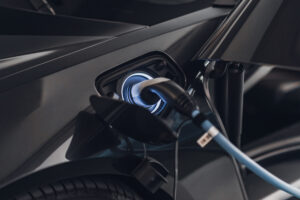
Consumer EV interest stable amid potential federal and state policy changes
By onMarket Trends | Technology
Despite uncertainty around future EV interest and potential economic headwinds hanging over the automotive industry, consumer demand has remained stable, according to J.D. Power’s 2025 U.S. Electric Vehicle Consideration (EVC) Study.
Twenty-four percent of vehicle shoppers surveyed said they would “very likely” consider purchasing an EV, and 35% said they would “somewhat likely” consider the purchase, both of which remain unchanged from a year ago, according to the study.
“Despite the market volatility, EVs have found a solid ground for consumer consideration,” said Brent Gruber, J.D. Power’s executive director of EV practice, in a press release. “To further capitalize on that interest and spur adoption moving forward, the industry needs to have products that meet consumer needs and wants at prices that are affordable. Additionally, the industry should better educate consumers about EV ownership to ease concerns — many of which, such as those related to public charging, are less problematic than they might seem when it comes to actually owning an EV.”
Of those who said they would “very likely” consider buying an EV, cross-shopped an average of 2.9 brands, while those who say they are “somewhat likely” shop an average of 2.8 brands. J.D. Power found the same to be true in its 2024 U.S. Sales Satisfaction Index Study, which found EV buyers shopped three dealer brands compared to 2.5 for gas-powered vehicle shoppers.
“As more EV options come to market, this should serve as an encouraging sign for automakers because it’s an opportunity for them to gain a foothold and pull shoppers from outside their brands,” Gruber said, in the release. “This year’s study results also show that EV shoppers consider products from mass market and premium brands alike, highlighting the opportunity to capture consumer interest with brands or products that shoppers may not have otherwise considered.”
Charging station availability remains shoppers’ top concern, with 52% citing it as a reason for not purchasing an EV.
J.D. Power concludes that the continuing concern with charging, coupled with flattening overall EV interest, points to a lack of progress in consumer education on these issues. However, while consumer rejection due to purchase price has dropped 4 percentage points year-over-year to 43%, concern with cost of ownership has dropped 2 percentage points to 33%.
The study also found that 17% of consumers in the 25-49 age range have an annual income of over $100,000.
“It’s an interesting dichotomy because younger consumers are the most receptive to EVs, but also the least likely to be able to afford them, while older consumers have the financial means but show less interest,” Gruber said, in the release. “Much of the recent growth in the EV space has been fueled by products from mass market brands, which demonstrates the pent-up demand for more affordable products.”
Midwest states are least enthusiastic about EVs, with the lowest shares of consumers who say they are “very likely” to consider purchasing an EV living in Wisconsin and Kentucky (18% each), Minnesota (17%), and Ohio (16%).
J.D. Power says this is influenced by several factors, including concerns about EV performance in cold climates and the stronger loyalty of consumers in these regions to traditional automakers.
This year’s study is based on responses from 8,164 consumers who said they intend to buy or lease a new vehicle in the next year, and was fielded from January through April 2025.
Recently, some state governors have paused EV sales incentives and/or requirements, including Delaware and Vermont.
On May 13, Vermont Gov. Phil Scott issued an executive order directing the Agency of Natural Resources to pause enforcement of a multi-state plan requiring vehicle manufacturers to meet certain EV sales targets for passenger cars and medium- and heavy-trucks.
“I continue to believe we should be incentivizing Vermonters to transition to cleaner energy options like electric vehicles,” he said, in a press release. “However, we have to be realistic about a pace that’s achievable. It’s clear we don’t have anywhere near enough charging infrastructure and insufficient technological advances in heavy-duty vehicles to meet current goals. We have much more work to do, in order to make it more convenient, faster, and more affordable to buy, maintain, and charge EVs. When we do, it’s more likely everyday Vermonters will make the switch.”
Scott said he remains committed to addressing climate change, including advocating for more charging infrastructure, but emphasized that when it comes to transitioning to a low-carbon future, mandates are not going to be the total answer. Instead, using common sense and incentivizing technological advancements are necessary to overall success, and the new compliance flexibility is intended to reflect that reality, he said in the release.
At the federal level, EV tax credits remain in limbo, according to a May 6 Bloomberg article in which U.S. House Speaker Mike Johnson said House Republicans might end the credit.
President Donald Trump has made EVs a policy focus, including proposing to cut $15 billion in clean energy projects and subsidies as part of his recently released budget outline.
However, some automakers continue to move forward with expanded EV plans.
Last week, at the Financial Times Future of the Car Summit in London, Kia announced it would carry out the world’s first trial of a Battery Passport vehicle — a digital-first solution that tracks and analyzes EV batteries at the cellular level.
“The trial vehicle is capable of monitoring live data for each battery cell and uploading it to a digital passport,” said Jens Brech, Kia’s director of ownership experience. “This close analysis will help extend battery life, reduce long-term costs, and build greater customer trust in EV batteries.”
Kia also unveiled its PV5, the automaker’s first Platform Beyond Vehicle (PBV), and its collaboration with Motability Operations to develop a wheelchair-accessible variant (WAV) of the PV5. The PV5 caters to ride-hailing, last-mile delivery, trades, families, and camper vans.
Images
Featured image credit: microgen/iStock
